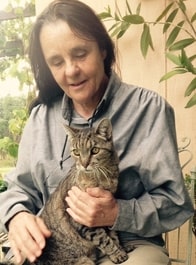
Most people have heard of male cats being called a tom or a tomcat. More people wonder what a female kitten or a grown female cat is called as a nickname.
The answer is, molly. However, when a female cat gets pregnant and gives birth to kittens, she becomes a queen.
A female kitten can also be a dam, but only if she is a special breed and someone is listing her in a register of cats of that breed.
Read on to learn more words and names for female kittens and cats, and where these words came from as terms for describing felines.
Why Female Kittens are Called Molly
No one knows for sure how female cats came to be called molly. My old, dusty dictionary does not contain this meaning of the word, so it is probably a slang term for a cat more than a technical term like dam, which is in the dictionary.
We know that the name Molly is a nickname Margaret and Mary’s names, and for centuries, these were among the most common first names for girls – humans, that is.
Molly also turns out to be a term used in Ireland for a lower class girl or woman. Perhaps the name came from there and somehow became a generic name for female kittens and cats.
A molly can be any age, and she may be spayed or able to have kittens. Unlike the term tomcat, a molly is not a molly-cat: She’s just a molly unless she becomes a queen.
When a Molly Becomes a Queen

Many cat-lovers think of their female feline friends as princesses, so it makes sense that the word queen also describes female cats.
A molly becomes a queen when she reaches adulthood and is ready to breed when she is pregnant, and while she nurses and cares for her litter.
When she delivers her kittens, it’s called queening.
Technically, a queen cat is an unsprayed female capable of breeding and not a kitten. The term queen for cats started with English cat breeders, probably as a joke about the Queen of England.
Feral cats living in a group of other cats frequently have a female group leader. This dominant female gets the best food and generally runs the show with the other cats, acting like their queen.
Because a female mother cat needs extra food to care for kittens, male cats, as the potential fathers of their offspring defer to the female around food.
They do this because it improves the male’s chances of passing on his genes through healthy kittens the mother feeds.
People who live with more than one cat in their household also often say that one female cat takes the leadership position and dominates the other cats, male and female.
No doubt, this frequent observation also led to female cats becoming queens in the language of their owners.
A Purebred Female Kitten Can Be Called a Dam
The word ‘dam’ for a female kitten or grown female cat is mostly a term used by cat breeders in reference to a purebred female kitten or cat that the people are breeding for sale or showing.
If your female kitten is a registered rare breed, then she is technically a dam, according to cat breeders.
But you are unlikely to see the word dam used for female kittens except in documents kept by cat breeders and their organizations. The term is also used for other types of female animals, including horses and chickens.
Why Some Female Cats are Called Dams
The word dam in reference to domestic animals goes back to Old English and the 1200s. Since that time, English speaking people have used this word to describe a female parent of various domestic animals, including domestic cats.
In the famous play Macbeth, Shakespeare has one of his characters refer to his wife and children using a metaphor involving the word ‘dam’ when McDuff says,
“What, all my pretty chickens and their dam, at one fell swoop?”
He says this when he finds out someone killed them all.
The word dam comes from the word dame, another old English word for a high-class lady. In the US in the 1940s, dame became a word used for almost any woman.
For centuries, the Queen of England has made some women Dames, the equivalent of a male Knight. So, female felines seem to have a substantial claim to royalty.
Tomcats and Other Cat Words
Most people are familiar with using the name tom for a male cat. The word tomcat is also a name for an adult male cat unless he’s neutered. Male turkeys also share the name of tom with male cats.
Unlike the mystery of the molly’s origins, the reason male cats are called tom traces back to a book written in the 1800s called “The Life and Adventures of a Cat.”
In this satirical novel, a male cat named Tom roams around finding his queens. The book was popular in its day, and it appears to be the origin of the term tom and tomcat, referring to unaltered male cats. Before that, they were called ‘rams.’
A neutered male cat is called a ‘gib,’ and a group of cats is a ‘clowder,’ related to an Old English word for clutter.
The word cat comes from the ancient Roman’s Latin language when a cat was called a ‘catus.’ The word ‘queen’ has also been around a long time, originally meaning any honored woman or female ruler.
The word kitten is a short form of the word for cat from the old German language. The babies of several small species of wild cat such as lynxes and ocelots are also called kittens.
However, the baby cats of larger felines like lions and tigers are called ‘cubs.’
Differences between a Tom and a Molly Cat
Female and male cats are not the same biologically or in personality, although there is a lot of variety between different individual kittens and adult cats.
Cats’ behavior also changes when they are neutered or spayed, and how it changes depends on whether they start life as a tom or a molly.
When a molly doesn’t get spayed, she will have times when she becomes a queen. If there is more than one molly, they may fight for dominance.
When a molly goes into heat and becomes a queen, things can get pretty wild.
She may roll around, make weird meowing or growling sounds, put her rump in the air, act aggressively or be protective of kittens or favorite objects. If there are tomcats around, this behavior will certainly attract their attention.
Unneutered male cats are notorious for roaming around the neighborhood looking for a queen. They can travel quite a distance and be gone for days on their adventures.
Other common and not so pleasant behaviors of toms include spraying urine to mark their territory and becoming aggressive when encountering other cats or even people.
After neutering, male cats often become docile and friendlier, and they tend not to roam as much or at all.
Female cats’ personalities do not change as much as males after spaying. However, neutered females no longer go into heat, and they are not as popular with the neighborhood toms.
Popular Names for Female Kittens
Whether your kitty is a molly, a queen, or a dam, she still needs a personal name, and finding the right name for your kitten’s personality is part of the joy of being a cat parent.
Queenie might be an appropriate name for a female kitten, but it doesn’t appear on the top 10 and top 20 lists of female kitten names. But Molly does, along with:
- Chloe
- Bella
- Lily
- Luna
- Mia
- Princess
- Gracie, and
- Kitty
Conclusions about Names for Female Kittens
We call female kittens a molly unless they become a queen. Female cats are known as queens as long as they are unaltered adults in the mood for breeding, pregnant, or lactating.
Once a queen is no longer in heat, pregnant, or caring for kittens, she becomes a molly again, even though she may still act like the queen of the house.
A neutered female cat is always a molly, and only female kittens or cats with official breeding papers raised for breeding are called dams.
